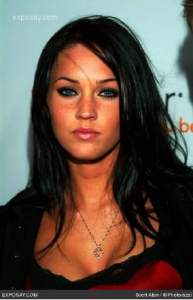Judging Beauty by Math
Guest post by Ville Satopaa ’11 from my Discrete Mathematics 251 class.
We all know of the famous Fibonacci sequence
0, 1, 1, 2, 3, 5, 8, 13, …
in which each term is the sum of the previous two.
When tends to infinity, the ratio between the
term and the
term gets closer and closer to something that we call the Golden Ratio, denoted by
:
This ratio seems to define beauty to some extent. In fact, it turns out that a person with a beautiful face has nose, eye position, the length of chin and many other measurements of the face in the Golden Ratio. Here are some measurements that should follow the Golden Ratio:
1. length of the face / width of the face
2. width of the mouth / width of the nose
3. width of the eyebrows / the distance between the pupils.
4. outside distance between eyes / hairline to pupil
5. nose tip to chin / mouth to the chin
Well, are faces with ratios close to the Golden Ratio actually beautiful? Fortunately, it is easy to test this. Let’s pick a photo of an attractive person looking directly at the camera, so that it is easy to make the measurements.

Using this picture of Meghan Fox from exposay.com I measured the following ratios (the picture pasted to this file is of difference size):
1. 7.1 / 4.3 = 1.65116
2. 1.6 / 1.0 = 1.6
3. 3.3 / 1.9 = 1.73684
4. 2.9 / 2.1 = 1.38095
5. 2.0 / 1.3 = 1.53846
The mean ratio turns out to be , and the mean difference from the Golden Ratio turns out to be
. Therefore her face is overall quite close to the Golden Ratio. However, whether this provides evidence that the Golden Ratio can be used as an estimate of beauty depends on whether you consider Meghan Fox attractive or not. I personally do.
 Welcome to my blog. I also have a blog at the
Welcome to my blog. I also have a blog at the
Sean:
This is MY definition of beauty:
http://cornelius1.com/blog/uploads/800px-Fibonacci_spiral.svg.png
3 November 2008, 2:03 pmSean:
Actually for a more serious response, this post came to mind when in a recent psychology lecture we were learning about attractiveness. The theory is that the more ‘average’ a person’s looks are, the better looking they will be. At first this sounds like a paradoxical idea, but turns out to be almost unsettlingly possible – when taking a number of faces (at least 30 or so) and using a computer to ‘morph’ them together, the result (an average of each individual face) turns out to be relatively objectively attractive. Check out this link for an example:
http://en.wikipedia.org/wiki/Averageness
I don’t know exactly how this relates to discussions on the Golden Ratio in people’s faces, but I wouldn’t be surprised if the Golden Ratio was actually very close to the average ratios of different facial features. If so, the Golden Ratio idea about attractiveness would have grounds in not only mathematics but social and evolutionary psychology as well.
11 November 2008, 9:35 pmtimur:
It is not clear that the difference 0.11 can actually be considered “close”. I think we need to know how this difference would be for an average or an “ugly” person.
3 December 2008, 1:04 amkatie:
So I still don’t get how you would measure and compare yourself. Can you maybe help me understand it a bit better?
6 January 2009, 10:34 pmVille:
Sure Katie!
If you want to measure yourself, you should take a picture of yourself facing the camera (like the one above of Meghan Fox). I did this to myself using the webcam on my Mac. Then using that picture and perhaps a ruler, obtain all necessary measurements that I listed above with the instructions on how to calculate the correct ratios. Just read those 5 parts and see what measurements you need. Now that you have all those measurements, you can calculate the ratios, the mean difference (this is absolute) between each ratio and the golden ratio and finally the overall mean difference from the golden ratio. This will give you an estimate on how far away your face is from the golden ratio. Therefore if you want to compare two values, the smaller value indicates a face that is mathematically more beautiful.
I hope this explained it a bit better. Let me know if some part still confuses you, or if my answer did not answer your question.
7 January 2009, 6:07 amFrank Morgan:
Check out this morphing of the 44 Presidents from Washington to Obama.
12 January 2009, 10:25 amVille:
I found a website where you can upload photos and average them out:
http://www.faceresearch.org/demos/average
It requires you to register. Registering takes about 20 seconds. I tested the program by merging my face with some others. It seems to work quite well, if you have a clear picture of yourself facing the camera.
I remember at some point there was some talk about averaging the faces of the 251 students and putting it in the front of a class t-shirt. This could work!
13 January 2009, 5:31 amEmma:
How do you calculate the difference from the golden ratio??????
31 January 2009, 1:31 amVille:
Take the absolute difference between the golden ratio and a single ratio that you obtained through measuring the face you are interested in. Let’s say you calculated 5 different ratios from the face. Then you will end up having 5 differences. Take the mean of those differences and you have an overall estimate on how far away the face is from the golden ratio.
So, a quick answer to your question. Absolute difference should be used.
31 January 2009, 11:43 amJordan Remmes:
My mean ratio is 1.55
4 April 2009, 11:33 pmMost people consider my face to be attractive–from the front. I believe side profiles have a lot to do with determining beauty. I do not consider my side profile to be attractive.
Al:
Does anyone know of a site that u can upload pics onto and it will average out ur beauty… or even go further by showing u areas of ur face that dont follow the ration?
6 April 2009, 1:05 amDonald:
I don’t understand how to find the mean difference from the Golden ratio. My mean ratio is 1.6046. Can someone help me?
14 May 2009, 3:27 amHenry:
Donald, just subtract to get the difference
30 June 2009, 12:45 pmABS (1.6046-1.618) = 0.0134
That is pretty close to perfect, but you’ll have to ask a stranger to know for sure.
Donald:
Oh that was a lot easier than I was trying to make it. Thank you very much, Henry. And I don’t know what it is that I am supposed to ask a stranger, but thanks a lot for your help :).
18 July 2009, 2:39 amBetty:
Beauty has been a gift for women since ancient times. Though it sounds partial, beautiful women have always been given preference over an average looking woman. Every woman is born beautiful in some way or another. What we need to do is focus on our strong traits and enhance them and they will take care of our traits that do not resemble us in a very beautiful manner.
26 August 2009, 5:05 amCJ:
My mean number was 1,633 , so I scored a 0,015. I thought it was pretty funny, I don’t consider myself THAT pretty haha. Really, it’s the inside that counts after all ! 🙂
13 November 2009, 9:56 amGina:
That was an interesting way to spend 5 minutes. I got 1.60225 so I’m 0.01575 away. But I would like to repeat an earlier question, from timur: how do we know what is “close” and what isn’t? What would be the ratio for an average or unattractive person?
18 November 2009, 11:27 amHair Salons:
That is so funny. I wanted whether anyone can get a perfect beauty score with this equation! And don’t you think that we should find a way to equate the hairstyle in there?
1 December 2011, 1:50 pm